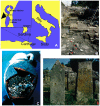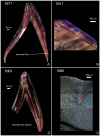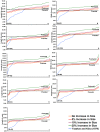Skeletal remains from Punic Carthage do not support systematic sacrifice of infants
- PMID: 20174667
- PMCID: PMC2822869
- DOI: 10.1371/journal.pone.0009177
Skeletal remains from Punic Carthage do not support systematic sacrifice of infants
Abstract
Two types of cemeteries occur at Punic Carthage and other Carthaginian settlements: one centrally situated housing the remains of older children through adults, and another at the periphery of the settlement (the "Tophet") yielding small urns containing the cremated skeletal remains of very young animals and humans, sometimes comingled. Although the absence of the youngest humans at the primary cemeteries is unusual and worthy of discussion, debate has focused on the significance of Tophets, especially at Carthage, as burial grounds for the young. One interpretation, based on two supposed eye-witness reports of large-scale Carthaginian infant sacrifice [Kleitarchos (3(rd) c. BCE) and Diodorus Siculus (1(st) c. BCE)], a particular translation of inscriptions on some burial monuments, and the argument that if the animals had been sacrificed so too were the humans, is that Tophets represent burial grounds reserved for sacrificial victims. An alternative hypothesis acknowledges that while the Carthaginians may have occasionally sacrificed humans, as did their contemporaries, the extreme youth of Tophet individuals suggests these cemeteries were not only for the sacrificed, but also for the very young, however they died. Here we present the first rigorous analysis of the largest sample of cremated human skeletal remains (348 burial urns, N = 540 individuals) from the Carthaginian Tophet based on tooth formation, enamel histology, cranial and postcranial metrics, and the potential effects of heat-induced bone shrinkage. Most of the sample fell within the period prenatal to 5-to-6 postnatal months, with a significant presence of prenates. Rather than indicating sacrifice as the agent of death, this age distribution is consistent with modern-day data on perinatal mortality, which at Carthage would also have been exacerbated by numerous diseases common in other major cities, such as Rome and Pompeii. Our diverse approaches to analyzing the cremated human remains from Carthage strongly support the conclusion that Tophets were cemeteries for those who died shortly before or after birth, regardless of the cause.
Conflict of interest statement
Figures





Similar articles
-
Deficit of skeletal remains belonging to infants and young children - but not at every cemetery!Anthropol Anz. 2023 Sep 28;80(4):385-395. doi: 10.1127/anthranz/2023/1657. Anthropol Anz. 2023. PMID: 37020417
-
New insights into Eastern Beringian mortuary behavior: a terminal Pleistocene double infant burial at Upward Sun River.Proc Natl Acad Sci U S A. 2014 Dec 2;111(48):17060-5. doi: 10.1073/pnas.1413131111. Epub 2014 Nov 10. Proc Natl Acad Sci U S A. 2014. PMID: 25385599 Free PMC article.
-
Kings and peasants from El-Zuma/El-Detti microregion in the Early Makurian period. Economic aspects of animal bones from funerary contexts.PLoS One. 2019 Feb 15;14(2):e0212423. doi: 10.1371/journal.pone.0212423. eCollection 2019. PLoS One. 2019. PMID: 30768626 Free PMC article.
-
Skeletal preservation of children's remains in the archaeological record.Homo. 2015 Dec;66(6):520-48. doi: 10.1016/j.jchb.2015.04.003. Epub 2015 Aug 24. Homo. 2015. PMID: 26391374
-
Short review: field recovery and potential information value of small elements of the skeleton.Homo. 2011 Aug;62(4):270-9. doi: 10.1016/j.jchb.2011.06.003. Epub 2011 Jul 7. Homo. 2011. PMID: 21741041 Review.
Cited by
-
New regression formula to estimate the prenatal crown formation time of human deciduous central incisors derived from a Roman Imperial sample (Velia, Salerno, Italy, I-II cent. CE).PLoS One. 2017 Jul 12;12(7):e0180104. doi: 10.1371/journal.pone.0180104. eCollection 2017. PLoS One. 2017. PMID: 28700601 Free PMC article.
References
-
- Brown S. Sheffield: JSOT Press; 1991. Late Carthaginian Child Sacrifice and Sacrificial Monuments in their Mediterranean Context.
-
- Harden D. New York: Frederick A. Praeger; 1963. The Phoenicians.
-
- Mosca PG. Cambridge, MA: Harvard; 1975. Child Sacrifice in Canaanite and Israelite Religion.
-
- Stager LE, Greene JA. Child sacrifice: yes, children of Phoenician/Punic Carthage were sacrificed to the gods. 2007. pp. 2–3. http://phoeniciaorg/childsacrificehtml.
-
- Stager LE, Wolf SR. Child sacrifice at Carthage: Religious rite or population control. Biblical Archaeology Review. 1984;10:31–51.
Publication types
MeSH terms
LinkOut - more resources
Full Text Sources
Miscellaneous

